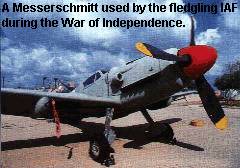In the War of Independence
(1948)
The Sherut Avir (Air Service) was organized
under the aegis of the Haganah two weeks before the U.N. vote
for partition in November 1947. Starting with fewer than a dozen
light airplanes, most of them borrowed from “Aviron,” the
Jewish airline, Sherut Avir barely made a ripple in the swirling current
of events. It did succeed, however, in accomplishing a number of missions:
it maintained contact with besieged settlements, accompanied convoys
and occasionally helped to beat back attacks. More importantly, it laid
the foundation on which a real force could be built.
As independence — and the Arab invasion —
drew near, an effort was made to acquire “real” aircraft and
find the men to fly them. Dummy companies were set up on several continents
to buy a wide variety of planes through incredible means. At the same
time, a call went out which attracted a most unusual cadre of seasoned
World War II pilots: Jews and Gentiles, idealists and adventurers, volunteers
and mercenaries. Together, they created an Air
Force with a unique flavor.
On May 14,
1948, Israel became a reality. The next day, Arab
forces invaded by land and bombed Israeli cities by air at will. Against
this desperate backdrop, the First Fighter Squadron was formed. On its two initial missions, it stopped
an Egyptian advance and put an end to the bombing of
Tel Aviv. Additional aircraft soon began to arrive.
Spitfires and Mustangs provided real muscle. Harvards
dive-bombed. A few B-17's arrived via Czechoslovakia, bombing Egypt on their way
to Israel. The IAF then brought the war to Arab cities.
Gaza, El-Arish, Cairo, Amman and Damascus were now within
reach.
When the southern settlements of the Negev were cut off,
a makeshift airstrip was readied near Kibbutz Dorot,
and Operation Avak (Dust) was born. The IAF helped regain
control of the Negev in Operation Yoav. During Operation
Horev, IAF pilots shot down five RAF planes in two dogfights
on January 7, 1949. In all, 15 Egyptian and two Syrian
planes were downed during the War of Independence. Yet
the glory of aerial combat did not come cheaply: 31
fliers gave their lives during the war.* Most fell from ground-fire, some to the dangers of flying
machines of questionable airworthiness. Yet the bottom
line was that Israel's skies were now secure ... and
would remain so.
The First IAF Fighter Mission:Stopping and Egyptian Column Near Ashdod (May 29, 1948)

With little to defend itself in May '48, Israel hurriedly
purchased a number of second rate Czech-made Messerschmitts. The
planes were taken apart, transported to Israel at night, and
secretly reassembled at Ekron (later to become Tel Nof Air Force
Base). The first pilots hoped to employ this force against the
main Egyptian air threat based at El Arish.
Yet fate had other plans for them. An Egyptian column of some
500 vehicles was making its way up the Coastal Road towards Tel
Aviv. The column halted briefly at a bombed-out bridge near
Ashdod. Barely 20 miles separated the enemy from its objective.
With no alternative, the first four fully assembled planes were
pressed into action. Lou Lenart, an experienced American
volunteer, was selected to lead the historic mission. He was
joined by Moddy Alon, Ezer
Weizman and Eddie Cohen.
Each plane swooped down on the enemy with two 70-kg bombs.
They continued to strafe the column despite heavy ground fire.
Unfortunately, the Messerschmitts' untested 20 mm cannons and
machine guns jammed quickly and the few rounds that they fired
didn't inflict much damage. But the psychological effect was
enormous. The surprised Egyptians scattered for cover in the face
of a bona fide aerial attack. By the time they regrouped, they
had lost the offensive.
Israel's outnumbered Givati forces seized the opportunity to
launch a counterattack and stopped the advance in its tracks. The
bombed-out bridge later became known as Gesher Ad Halom (Until
Here). The price of success was high: Eddie Cohen, a South
African-born pilot, was killed when his Messerschmitt crashed and
burned. As a result, the First Fighter Squadron lost one-fourth
of its aircraft and one-fifth of its pilots on its maiden combat
sortie. This was to set the tone for the future: achieving the
mission despite personal sacrifice.
The First Aerial Victory (June
3, 1948)
The significance of the IAF's first successful engagement went
far beyond the glory of shooting down an enemy plane. In the
first days of Israel's independence, it was the Arabs who enjoyed
complete freedom in Israeli skies. Egyptian Dakota transports
were used as bombers and attacked Tel Aviv with impunity. Moddy
Alon, commander of the First Fighter Squadron, decided to put an
end to this intolerable situation.
As the air raid sirens went off, Tel Aviv residents
were surprised to see a small, dark spot rapidly approaching
the heavy bombers. Moddy fired his Messerschmitt's guns
at the first Dakota above the main streets of the city.
The enemy plane lost altitude and crashed in the dunes
south of the modern suburb of Bat Yam. Moddy then pursued
and caught the second Dakota. After taking a few well-aimed
rounds, the second aircraft was seen diving down towards
the coast west of Rehovot, a large black cloud signaling
its crash. In Tel Aviv there was dancing in the streets.
Grateful residents filled Moddy's hotel room with flowers,
champagne and chocolates: gifts to the pilot who saved
the city.
*Eddy Kaplansky, an
IAF pilot during the war notes that there were two additional
IAF casualties. Glenn King and Bill Gerson were killed
on April 21, 1948 when their heavily overloaded C-46
crashed on take-off at Mexico City airport while bound
for Israel with a military cargo. Kaplansky says these
two Americans were actually the IAF's first casualties.
Sources: Israel Defense Forces |